Are you someone who’s into making websites? If yes, you might have come across the words LAMP stack and MEAN stack. These are two highly prevalent methodologies for website development. However, what precisely do they entail, and in what ways do they diverge? How should you choose between them for your upcoming web project?
with Expert Web
Development Global web development by 150+ experts.
Specializing in LAMP, MEAN, and MERN.
Serving 20+ countries for over 10 years.

Within this presentation, we shall furnish you with comprehensive responses while conducting an intricate comparison between the LAMP stack vs MEAN stack.
Our aim is to provide you with the requisite insights to facilitate your decision-making process.
What is the LAMP Stack?
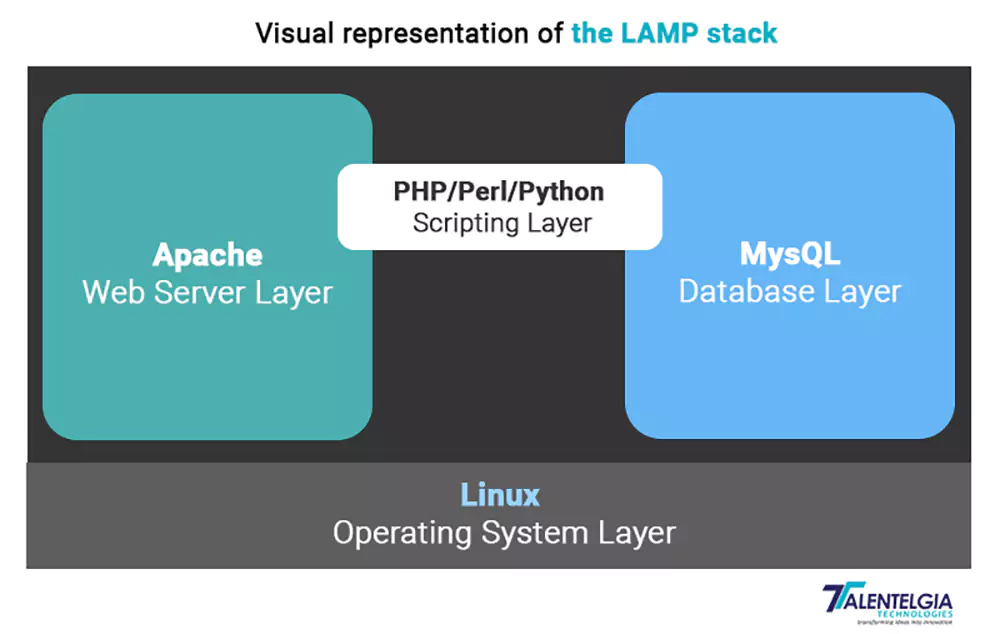
LAMP stands for Linux, Apache, MySQL, and PHP. It is a technology stack that consists of four open-source components:
- Apache is like a traffic cop for the internet. It takes requests from web browsers and gives them the web pages and files they want.
- MySQL is like a super organized librarian. It keeps track of all the information needed for web applications and helps find it when needed.
- PHP is like a magician on the web server. It creates special web pages that change and do cool things.
The LAMP stack is a really old and famous method for creating websites. Big websites have been using it since the 1990s like Wikipedia, WordPress, Facebook, and Yahoo use it.
What is the MEAN Stack?

MEAN is short for MongoDB, Express.js, AngularJS, and Node.js. It’s a set of four modern parts:
- MongoDB: Holds data in a format similar to JSON.
- Express.js: For web apps that runs on Node.js.
- AngularJS: To make the look and feel of web apps in your browser.
- Node.js: To run JavaScript on the server and manage web requests.
The MEAN stack is a new and cool way to build websites. It started in the early 2010s and is used by popular sites like Netflix, Uber, LinkedIn, and PayPal.
Key differences between LAMP and MEAN
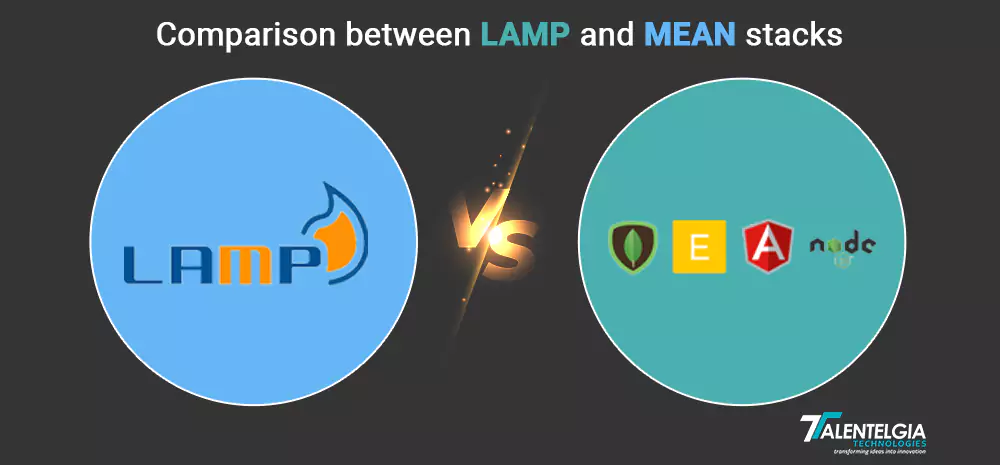
Let’s make a comparison between the LAMP and MEAN stacks:
LAMP vs MEAN Stack Comparison
| Aspect | LAMP | MEAN |
|---|---|---|
| Operating System | Uses Linux OS | Can use any OS that supports Node.js |
| Web Server | Uses Apache as the web server | Uses Node.js as the web server |
| Relational Database | Uses MySQL as the relational database | Uses MongoDB as the non-relational database |
| Programming Language | Uses PHP, Perl, or Python as the programming language | Uses JavaScript as the programming language |
| Frontend Development | Supports HTML and CSS for frontend development | Uses AngularJS for frontend development |
| Database Query Language | Uses SQL for querying the database | Uses JSON for querying the database |
| Stack Maturity | Older and more mature stack | Newer and more modern stack |
| Popularity and Support | More widely used and supported | Less popular and supported |
| Application Suitability | Suitable for static and dynamic web applications | Suitable for dynamic and scalable web applications |
Pros and Cons of LAMP Stack vs MEAN Stacks
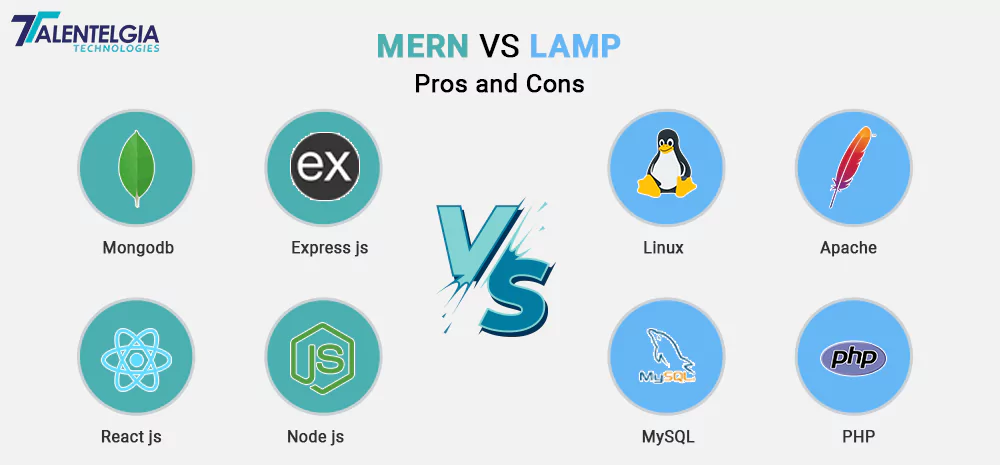
Now in the below section, we are going to summarize the pros and cons of LAMP stack and MEAN stack
LAMP Stack
Pros:
- Stability and Support: LAMP is a well-established technology stack with strong support and maintenance from a vast community of users. It’s a reliable choice for web development.
- Customization: You can adapt LAMP to your company’s specific needs by using numerous modules, libraries, and add-ons available.
- Open Source Community: Being Linux-based, you can easily find help and resources within the large open-source community.
- Reliable Database: MySQL, a part of LAMP, is a reliable and scalable database solution for your web applications.
- Mature PHP: PHP, the scripting language in LAMP, is fast, well-supported, and integrates seamlessly with the stack.
- Server Control: You have full control over the server, allowing you to decide which versions and software to install, reducing dependency on client-side browsers. This is ideal for server-side tasks.
Cons:
- Quality Concerns: Because PHP is easy to learn, some developers may not follow best practices, resulting in poorly built applications.
- Steep Learning Curve: Mastering PHP and ensuring security in PHP apps can be challenging.
- Not Pre-compiled: PHP is not pre-compiled, which might be seen as a disadvantage compared to languages like Java or C#.
MEAN Stack
Expert LAMP & MEAN
Stack Development Global LAMP & MEAN solutions by 150+
experienced developers. Serving 20+
countries for over 10 years.

Pros:
- JavaScript Everywhere: MEAN uses JavaScript for all levels of development, making it easy to find developers and allowing for quick setup.
- MongoDB: MongoDB, a NoSQL database in MEAN, offers schema-less data persistence and faster read performance compared to MySQL.
- Angular.js: Angular.js, maintained by Google, is a powerful client-side framework with frequent updates.
- Versatility: MEAN allows for easy development of mobile or desktop apps, such as with Ionic, and encourages code and component reuse.
Cons:
- Hype and Rapid Changes: MEAN’s popularity can lead to hype-driven development, and the fast release of new versions and libraries can make app maintenance challenging.
- Sustainability Concerns: As technologies evolve, some MEAN components may become obsolete, affecting the sustainability of MEAN-based projects.
- Code Maintenance: Maintaining a clean code base and following best practices can be more challenging as the app grows.
- Dependency on Client: MEAN stack projects may face usability issues if they rely on client-side technologies not universally supported.
Some of the Use Cases of LAMP Stack vs MEAN Stacks
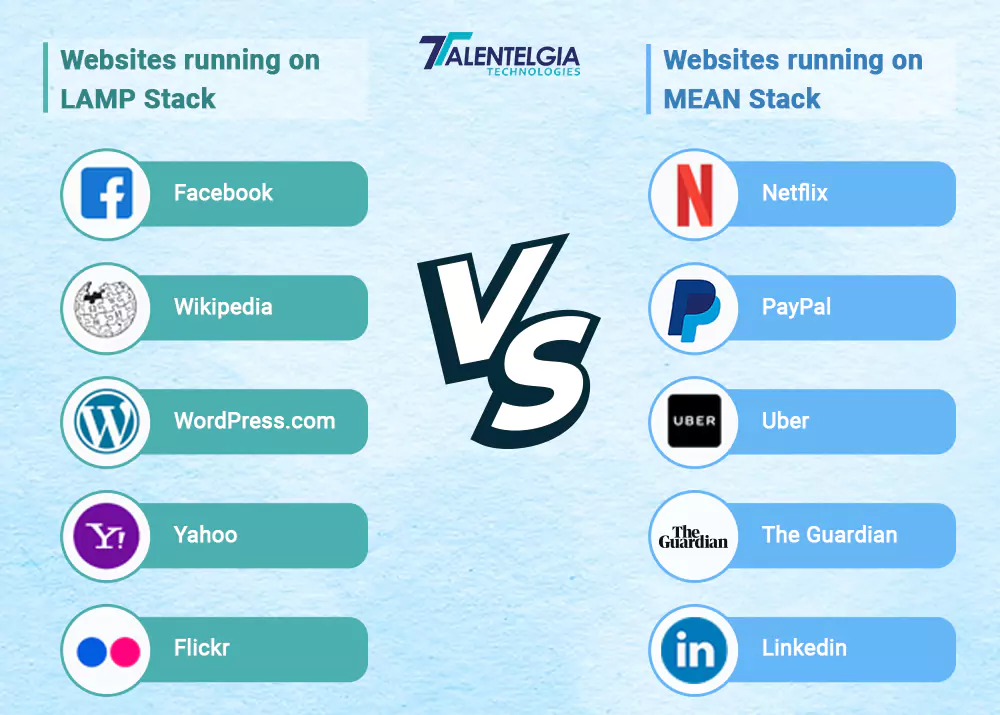
Here are some examples of the use cases of LAMP stack vs MEAN stack.
Websites running on LAMP Stack (Linux, Apache, MySQL, PHP/Perl/Python):
- Wikipedia
- WordPress.com
- Yahoo
- Flickr
Websites running on MEAN Stack (MongoDB, Express.js, AngularJS, Node.js):
- Netflix
- PayPal
- Uber
- The Guardian
Use cases of LAMP stack are:
- E-commerce websites, where databases underpin stock availability and enable customers to view past orders. For example, WooCommerce is a popular e-commerce platform that runs on LAMP stack.
- Media servers, where dynamic content is provided to people on demand, often through curated suggestions powered by a recommendation engine algorithm. For example, Netflix is a famous media streaming service that uses LAMP stack for its backend.
Use cases of MEAN stack are:
- Single-page applications, where the entire web page is loaded only once and updated dynamically without refreshing. For example, Gmail is a well-known single-page application that uses MEAN stack for its front end and back end.
- Real-time applications are those that instantly show updated information without any delays. For instance, Uber is a popular ride-booking service that uses something called the MEAN stack to track where cars are and make them communicate with each other.
- There are also apps like Facebook, where people can chat and share things. For example, LinkedIn is a professional networking app that uses the MEAN stack for both its website and mobile app.
This information can help you decide which set of tools is better for your website project.
Stats Comparison
These factors can guide you in choosing the right stack for your web development project.
- Popularity
The Stack Overflow Developer Survey in 2021 showed that PHP is the 8th most popular programming language, used by 25.8% of developers. JavaScript is the most popular, used by 64.2%, and Python is 3rd with 48.2%.
In the W3Techs Web Technology Surveys, LAMP is the top web stack, running 79.1% of websites with server-side programming. MEAN is 10th, running 0.2% of such websites.
When it comes to Performance:
- LAMP is often faster than MEAN due to MySQL, but MongoDB suits small projects.
- MEAN is known for speed and scalability, using JavaScript and JSON for faster database querying, though it can have memory and debugging issues.
For Scalability:
- LAMP handles many requests but may struggle with complex data.
- MEAN is highly scalable, handling concurrent connections and complex data effectively.
Regarding Security:
- LAMP is secure with a long history and security features.
- MEAN is relatively secure, using JavaScript and MongoDB to prevent attacks.
In terms of Ease of Use:
- LAMP is easy due to its wide usage, active community, and tool variety.
- MEAN is also user-friendly, using JavaScript for both server and client, simplifying code, and using JSON for fast database queries.
For Cost of Implementation:
- LAMP is free and open-source, and many hosting options are affordable.
- MEAN is likewise free, and services like AWS or Heroku can accommodate your needs without extra charges.
Other Stacks to Consider
- WISA Stack: Windows Server, IIS, Microsoft SQL Server, ASP.net – Ideal for Windows-based environments and seamless integration from Microsoft components.
- LAMP (With MongoDB): Combines traditional LAMP with MongoDB for added flexibility and scalability.
- Ruby Stack: Ruby on Rails was popular but has lost some popularity in recent years.
- Java+Spring: Preferred by large enterprises for its full-stack capabilities, but may be complex for indie developers.
- Django Stack: Loved by Python developers, Django offers good performance and is considered easy to learn.
Which tech stacks you should choose?
LAMP and MEAN stacks each have their pros and cons. Here are some things to think about when deciding between LAMP and MEAN:
- Operating system: LAMP stack allows developers to deploy web applications on a variant of Linux operating system only. MEAN, on the other hand, doesn’t list any operating system in their components. Therefore, with MEAN stack, users can deploy their apps on any OS that supports Node.js.
- Web server: LAMP stack uses Apache as the web server, which is a reliable and widely used software that can handle high traffic and complex requests. MEAN stack uses Express as the backend web framework, which is a lightweight and minimalist software that can be easily customized and integrated with other Node.js modules.
- Database: LAMP stack uses MySQL as the relational database management system, which is a powerful and scalable software that can store and manipulate structured data using SQL. MEAN stack uses MongoDB as the non-relational database, which is a flexible and agile software that can store and manipulate unstructured data using JSON.
- Programming languages in web development come in different stacks. LAMP stack uses PHP, an established language that makes dynamic web pages and talks to MySQL. Meanwhile, MEAN stack uses JavaScript, a modern language that works both on the front and back ends and connects with MongoDB.
Your choice depends on what your web app needs. If you’re looking for a professional web development company to help you pick and set up the right web stack, consider the best web development company. They’re experienced and offer cost-effective web solutions for various industries. Their skilled team can work with LAMP, MEAN, and other technologies to create innovative web apps that match your goals.
Conclusion
In conclusion, both the LAMP stack and the MEAN stack have their own strengths and weaknesses. The LAMP stack is a great choice for those who need a stable, robust, and well-supported platform for their web applications, while the MEAN stack is better suited for those who need a more lightweight and agile platform for their web applications.
The choice between them depends on various factors such as project requirements, developer preferences, budget constraints, and performance expectations. Therefore, it is important to evaluate these factors carefully before deciding which stack to use for your next web project.
FAQs
Q: What is the MEAN stack?
A: MEAN stands for MongoDB, Express.js, AngularJS, and Node.js. It is a technology stack that consists of four open-source components: MongoDB is like a flexible and fast librarian. It stores data in JSON-like documents that can have any structure and can be easily queried. Express.js is like a minimalist traffic cop for the web. It handles routing, middleware, and API creation for web applications. AngularJS is like a powerful magician on the web browser. It creates dynamic and interactive web pages that update automatically without reloading. Node.js is like a super-fast web server that runs JavaScript code. It can handle many concurrent requests without blocking or slowing down.
The MEAN stack is a newer and popular method for creating websites. It uses JavaScript as the main programming language for both the front end and the back end. Some websites that use it are Netflix, Uber, and LinkedIn.
Q: What are the main differences between the LAMP stack and the MEAN stack?
A: The main differences between the LAMP stack and the MEAN stack are:
- The LAMP stack uses different programming languages for the front end (HTML, CSS, JavaScript) and the back end (PHP, Python, Perl), while the MEAN stack uses JavaScript for both.
- The LAMP stack uses a relational database (MySQL) that stores data in tables with predefined schemas, while the MEAN stack uses a non-relational database (MongoDB) that stores data in flexible documents with dynamic schemas.
- The LAMP stack uses Apache as the web server that communicates with PHP via CGI or mod_php, while the MEAN stack uses Node.js as the web server that communicates with Express.js via callbacks or promises.
- The LAMP stack uses PHP as the backend framework that handles business logic and data access, while the MEAN stack uses Express.js as the backend framework that handles routing and API creation.
- The LAMP stack uses HTML as the frontend framework that renders static web pages, while the MEAN stack uses AngularJS as the frontend framework that renders dynamic web pages.
Q: What are the advantages and disadvantages of using the LAMP stack or the MEAN stack?
A: The advantages and disadvantages of using the LAMP stack or the MEAN stack are:
- The LAMP stack has the advantage of being stable, robust, and well-supported by a large community of developers. It also supports multiple programming languages and databases, giving more flexibility and choice to developers. However, it has the disadvantage of being slower, heavier, and more complex than the MEAN stack. It also requires more configuration and maintenance to keep it running smoothly.
- The MEAN stack has the advantage of being faster, lighter, and more agile than the LAMP stack. It also simplifies development by using one programming language and one data format across the entire stack. However, it has the disadvantage of being less mature, less secure, and less reliable than the LAMP stack. It also has a steeper learning curve and fewer resources available than the LAMP stack.


 Healthcare App Development Services
Healthcare App Development Services
 Real Estate Web Development Services
Real Estate Web Development Services
 E-Commerce App Development Services
E-Commerce App Development Services E-Commerce Web Development Services
E-Commerce Web Development Services Blockchain E-commerce Development Company
Blockchain E-commerce Development Company
 Fintech App Development Services
Fintech App Development Services Fintech Web Development
Fintech Web Development Blockchain Fintech Development Company
Blockchain Fintech Development Company
 E-Learning App Development Services
E-Learning App Development Services
 Restaurant App Development Company
Restaurant App Development Company
 Mobile Game Development Company
Mobile Game Development Company
 Travel App Development Company
Travel App Development Company
 Automotive Web Design
Automotive Web Design
 AI Traffic Management System
AI Traffic Management System
 AI Inventory Management Software
AI Inventory Management Software
 AI Software Development
AI Software Development  AI Development Company
AI Development Company  AI App Development Services
AI App Development Services  ChatGPT integration services
ChatGPT integration services  AI Integration Services
AI Integration Services  Generative AI Development Services
Generative AI Development Services  Natural Language Processing Company
Natural Language Processing Company Machine Learning Development
Machine Learning Development  Machine learning consulting services
Machine learning consulting services  Blockchain Development
Blockchain Development  Blockchain Software Development
Blockchain Software Development  Smart Contract Development Company
Smart Contract Development Company  NFT Marketplace Development Services
NFT Marketplace Development Services  Asset Tokenization Company
Asset Tokenization Company DeFi Wallet Development Company
DeFi Wallet Development Company Mobile App Development
Mobile App Development  IOS App Development
IOS App Development  Android App Development
Android App Development  Cross-Platform App Development
Cross-Platform App Development  Augmented Reality (AR) App Development
Augmented Reality (AR) App Development  Virtual Reality (VR) App Development
Virtual Reality (VR) App Development  Web App Development
Web App Development  SaaS App Development
SaaS App Development Flutter
Flutter  React Native
React Native  Swift (IOS)
Swift (IOS)  Kotlin (Android)
Kotlin (Android)  Mean Stack Development
Mean Stack Development  AngularJS Development
AngularJS Development  MongoDB Development
MongoDB Development  Nodejs Development
Nodejs Development  Database Development
Database Development Ruby on Rails Development
Ruby on Rails Development Expressjs Development
Expressjs Development  Full Stack Development
Full Stack Development  Web Development Services
Web Development Services  Laravel Development
Laravel Development  LAMP Development
LAMP Development  Custom PHP Development
Custom PHP Development  .Net Development
.Net Development  User Experience Design Services
User Experience Design Services  User Interface Design Services
User Interface Design Services  Automated Testing
Automated Testing  Manual Testing
Manual Testing  Digital Marketing Services
Digital Marketing Services 
 Ride-Sharing And Taxi Services
Ride-Sharing And Taxi Services Food Delivery Services
Food Delivery Services Grocery Delivery Services
Grocery Delivery Services Transportation And Logistics
Transportation And Logistics Car Wash App
Car Wash App Home Services App
Home Services App ERP Development Services
ERP Development Services CMS Development Services
CMS Development Services LMS Development
LMS Development CRM Development
CRM Development DevOps Development Services
DevOps Development Services AI Business Solutions
AI Business Solutions AI Cloud Solutions
AI Cloud Solutions AI Chatbot Development
AI Chatbot Development API Development
API Development Blockchain Product Development
Blockchain Product Development Cryptocurrency Wallet Development
Cryptocurrency Wallet Development About Talentelgia
About Talentelgia  Our Team
Our Team  Our Culture
Our Culture 
 Healthcare App Development Services
Healthcare App Development Services Real Estate Web Development Services
Real Estate Web Development Services E-Commerce App Development Services
E-Commerce App Development Services E-Commerce Web Development Services
E-Commerce Web Development Services Blockchain E-commerce
Development Company
Blockchain E-commerce
Development Company Fintech App Development Services
Fintech App Development Services Finance Web Development
Finance Web Development Blockchain Fintech
Development Company
Blockchain Fintech
Development Company E-Learning App Development Services
E-Learning App Development Services Restaurant App Development Company
Restaurant App Development Company Mobile Game Development Company
Mobile Game Development Company Travel App Development Company
Travel App Development Company Automotive Web Design
Automotive Web Design AI Traffic Management System
AI Traffic Management System AI Inventory Management Software
AI Inventory Management Software AI Software Development
AI Software Development AI Development Company
AI Development Company ChatGPT integration services
ChatGPT integration services AI Integration Services
AI Integration Services Machine Learning Development
Machine Learning Development Machine learning consulting services
Machine learning consulting services Blockchain Development
Blockchain Development Blockchain Software Development
Blockchain Software Development Smart contract development company
Smart contract development company NFT marketplace development services
NFT marketplace development services IOS App Development
IOS App Development Android App Development
Android App Development Cross-Platform App Development
Cross-Platform App Development Augmented Reality (AR) App
Development
Augmented Reality (AR) App
Development Virtual Reality (VR) App Development
Virtual Reality (VR) App Development Web App Development
Web App Development Flutter
Flutter React
Native
React
Native Swift
(IOS)
Swift
(IOS) Kotlin (Android)
Kotlin (Android) MEAN Stack Development
MEAN Stack Development AngularJS Development
AngularJS Development MongoDB Development
MongoDB Development Nodejs Development
Nodejs Development Database development services
Database development services Ruby on Rails Development services
Ruby on Rails Development services Expressjs Development
Expressjs Development Full Stack Development
Full Stack Development Web Development Services
Web Development Services Laravel Development
Laravel Development LAMP
Development
LAMP
Development Custom PHP Development
Custom PHP Development User Experience Design Services
User Experience Design Services User Interface Design Services
User Interface Design Services Automated Testing
Automated Testing Manual
Testing
Manual
Testing About Talentelgia
About Talentelgia Our Team
Our Team Our Culture
Our Culture
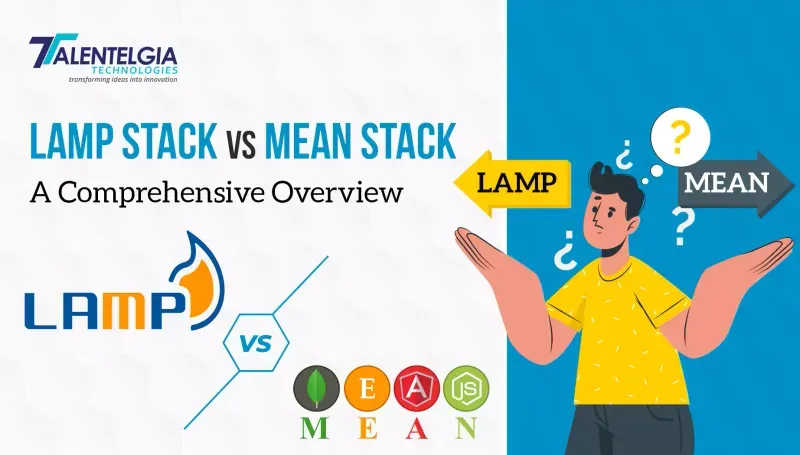

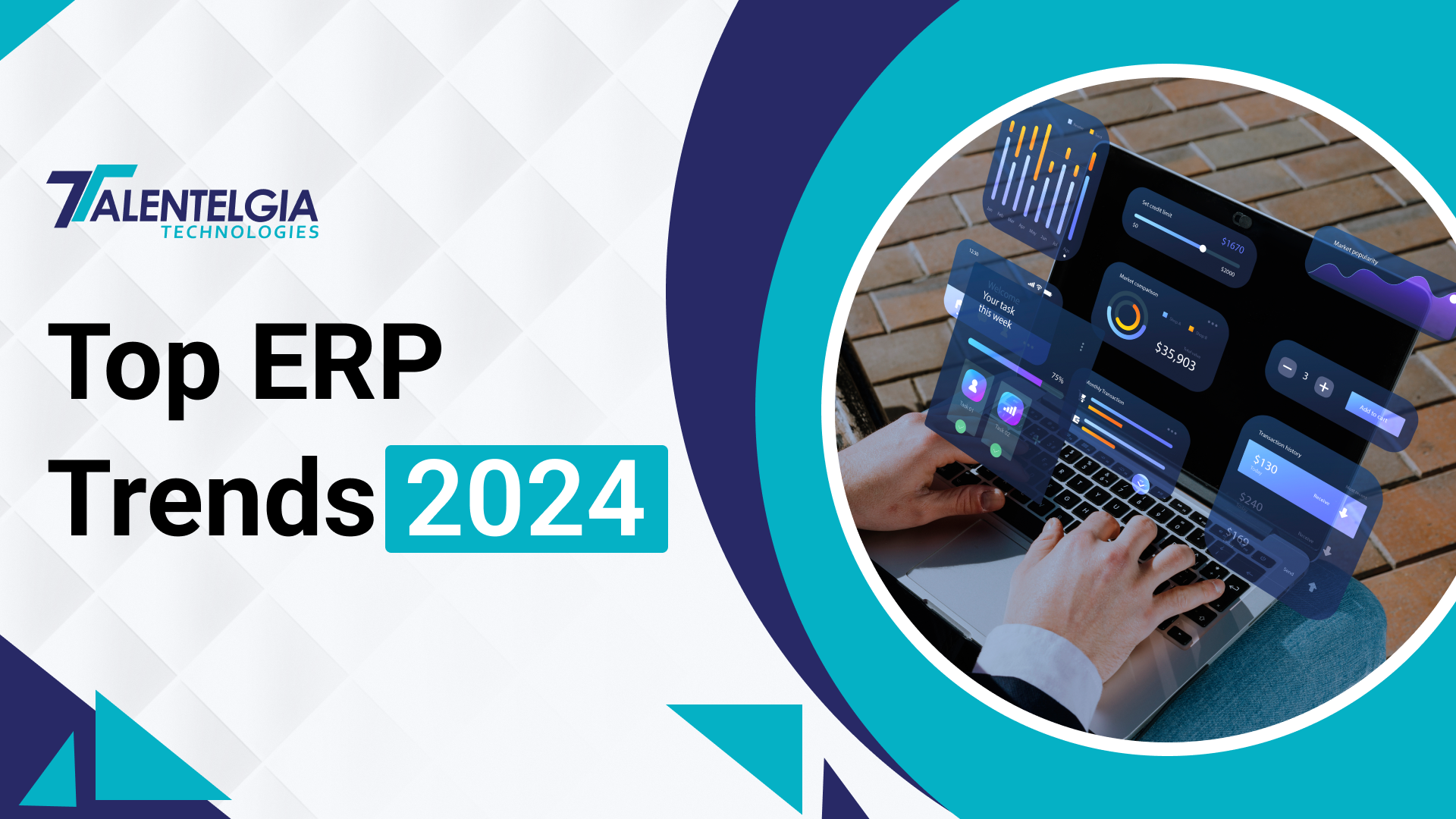

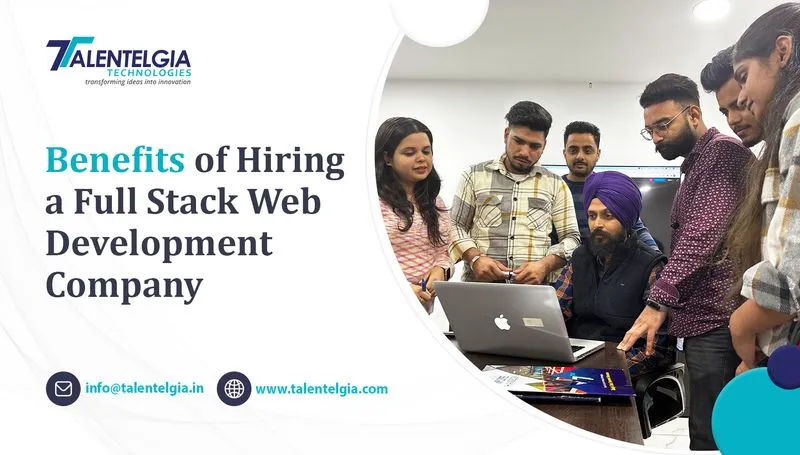
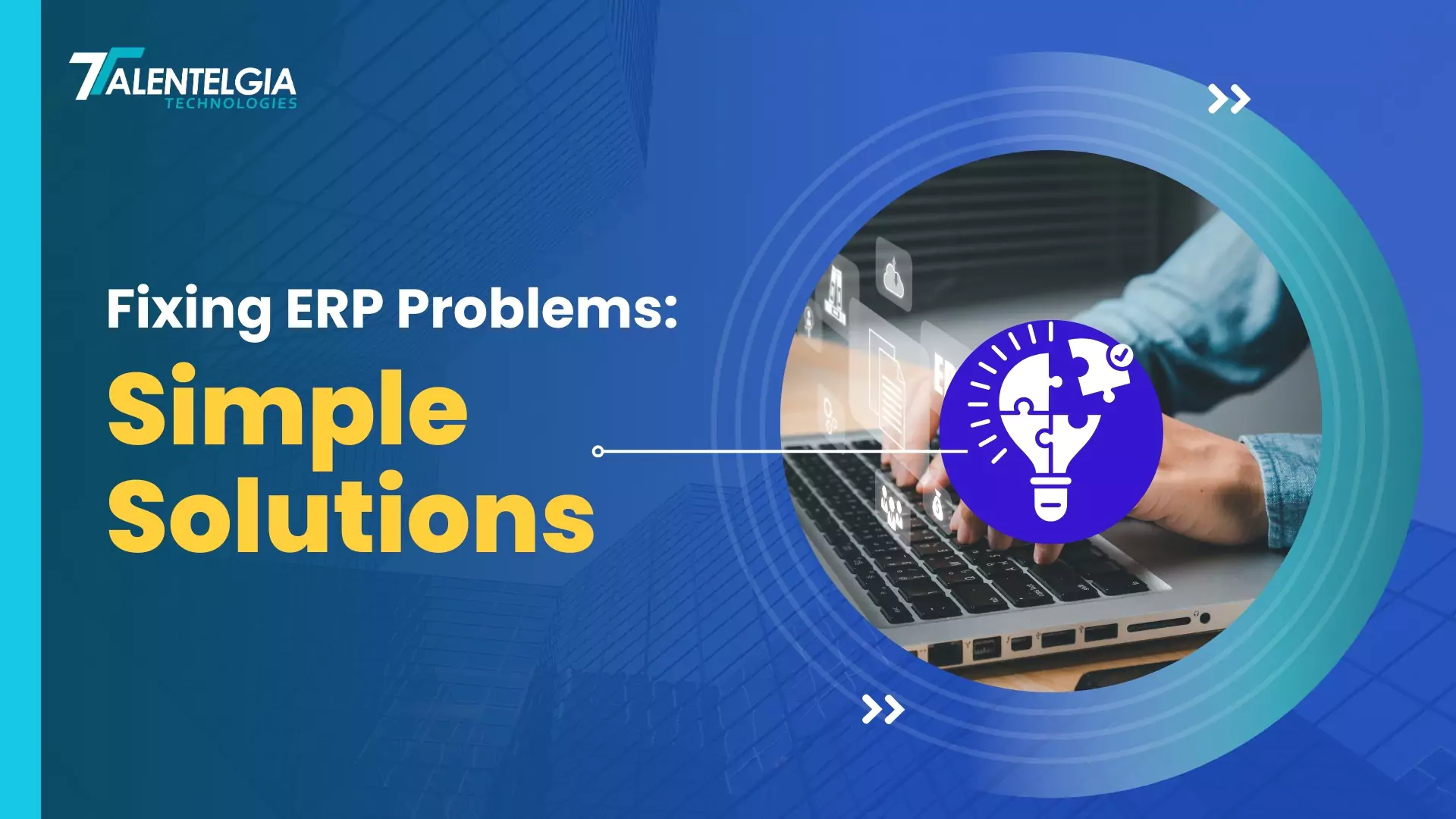











 Write us on:
Write us on:  Business queries:
Business queries:  HR:
HR: 




